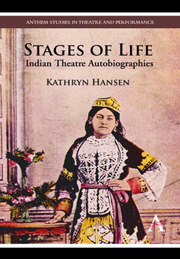Book contents
- Frontmatter
- Contents
- Illustrations
- Preface
- Acknowledgments
- PART 1
- PART 2
- PART 3
- 7 Self and Subjectivity in Autobiographical Criticism
- 8 Voices and Silences: Reading the Texts
- Appendix 1 Historical Personages and Institutions
- Appendix 2 List of Plays and Films
- Glossary: Hindi and Urdu Terms
- Bibliography
- Index
8 - Voices and Silences: Reading the Texts
from PART 3
Published online by Cambridge University Press: 05 March 2012
- Frontmatter
- Contents
- Illustrations
- Preface
- Acknowledgments
- PART 1
- PART 2
- PART 3
- 7 Self and Subjectivity in Autobiographical Criticism
- 8 Voices and Silences: Reading the Texts
- Appendix 1 Historical Personages and Institutions
- Appendix 2 List of Plays and Films
- Glossary: Hindi and Urdu Terms
- Bibliography
- Index
Summary
This final chapter offers critical readings of each of the four autobiographies. The points of entry chosen here illustrate the value of reading these narratives intertextually. Some of their shared themes have already been discussed. Historical motifs in the autobiographies and their character as ethnographic commentary have been treated in Chapter 2. The introductions preceding each translation summarize issues related to authorial style and translation. They also consider the manner in which each autobiographical text was elicited, assembled, and written.
The readings in this chapter, by contrast, engage directly with the performative self or selves voiced in these life stories. They query such classic autobiographical themes as childhood and destiny. They also explore authorial intentions and probe the topics about which the authors remain silent. The readings respond to each autobiography as a complete and unique whole, yet also survey them comparatively for greater insight. These sketches, it is hoped, will encourage readers to examine their own responses to the narratives and develop additional strategies for unfolding their multilayered meanings.
The Muted and the Voiced
In her study of the Bengali autobiography by Rashsundari, Sarkar outlines the paradoxical position of “muted groups” such as women in nineteenth-century Bengal. She cites the Ardeners to argue that muted groups lacked access to public modes of articulation and could not set cultural standards or norms. Instead, they laid claim to “a sliver of existence,” to practices and beliefs outside the prevailing culture.
- Type
- Chapter
- Information
- Stages of LifeIndian Theatre Autobiographies, pp. 315 - 335Publisher: Anthem PressPrint publication year: 2011

